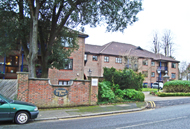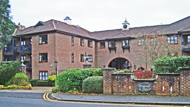Mental handicap
In 1924 the Braille and Servers of the Blind League was asked by the Ministry of Health to establish a home for blind mentally handicapped children. Such doubly afflicted patients needed more individual attention than they would get in a hospital for the mentally handicapped, and it was felt that they needed separate accommodation.
The first of the Ellen Terry Homes, named after the President of the League, Dame Ellen Terry, opened in Sandfield House, Reigate, in March 1925. It was the only hospital of its kind and accepted children up to the age of 10 years (another Home was planned that would take older children).
In 1934 the League built another house in the grounds of the Ellen Terry Home. The 2-storey building was named Daffodil House.In 1948 the Home joined the NHS, become affiliated with the Fountain Hospital, under the control of the Fountain Group Hospital Management Committee. The Home and Daffodil House were completely rewired and fitted with fire alarms, and redecorated throughout. A new gas range and refrigerator were installed in the kitchen. The verandah was enclosed to provide more bed space.
In 1950 the old coach house and a laundry were converted into an Occupations Centre. The well-equipped building was officially opened in May by Dr. A. Torrie, the Director of the National Association for Mental Health (now known as Mind). The new Centre freed up space in Daffodil House, which was altered to provide an extra ten beds for patient accommodation. The Home then had 50 beds for trainable mentally subnormal children. Its staff consisted of a Sister-in-charge, 8 day nurses, one night nurse, two teachers, a seamstress and a cook.
By 1959 the Home had 40 beds.
In 1963 the Fountain Hospital closed and control of the Home was transferred to Queen Mary's Hospital in Carshalton.
In 1970 a commercial firm provided contract cooking and cleaning because of difficulties in recruiting domestic and catering staff locally. In 1971 the Home was redecorated and a swimming pool for the patients built in a new extension, which was opened by Sir John Gielgud, great-nephew of Ellen Terry.
During the NHS reorganisation in 1974 the Home came under the control of the St Helier and Queen Mary's Hospital District, part of the Merton, Sutton and Wandsworth Area Health Authority. As it was outside the geographical area covered by the District, it was managed on an extra-territorial basis.
By 1985 there were 26 beds in the Ellen Terry Home and 12 in Daffodil House. Both closed in April 1986.
In 1987 the Ellen Terry Home was developed as a community-based short-term care unit with 8 bedrooms, before finally being converted into a Day Unit for those with challenging behaviour.
Present status (November 2009)
The buildings have been demolished and the Wray Park entrance closed off. In 1989 Wraymead Place, a block of retirement apartments, was built on the west side of the site with its entrance on Oak Road.
The new Ellen Terry Day Unit, a day service for adults with learning difficulties and challenging behaviour, is located at 9 Oak Road, while the new Daffodil House is at 7 Oak Road, behind Wraymead Place.


Wraymead Place
Ellen Terry was born in Coventry, the daughter of a provincial actor. She never went to school but, at the age of 8, she had appeared in The Winter's Tale at the Princess's Theatre in London, playing Mamillius, a little boy. She went on to establish herself as the leading Shakespearian actress of her time in Britain.
In 1878 she formed a partnership with Henry Irving at the Lyceum Theatre, where he became actor-manager. In 1903 she herself went into theatre management, having dominated English theatre for over 20 years. With her son Edward Craig, she helped to popularise the works of Henrik Ibsen and George Bernard Shaw.
She became almost blind in 1915 following a cataract operation (she is said to have thrown off the bandages too soon, being 'impatient of darkness').
Auerbach N 1997 Ellen Terry: Player in Her Time. Pennsylvania, University of Pennsylvania Press.
http://the-camerino-players.com
www.ellenterryarchive.hull.ac.uk
www. spartacus.schoolnet.co.uk
Lea A 2005 Royal Earlswood: A History. Redhill, Royal Earlswood Museum Committee.
http://hansard.millbanksystems.com
http://rcnarchive.rcn.org.uk (1925)
http://rcnarchive.rcn.org.uk (1950)
www.itnsource.com
www.nfo.ac.uk
www.oldmerstham.com
www.oldreigate.com
www.sabp.nhs.uk
Return to home page